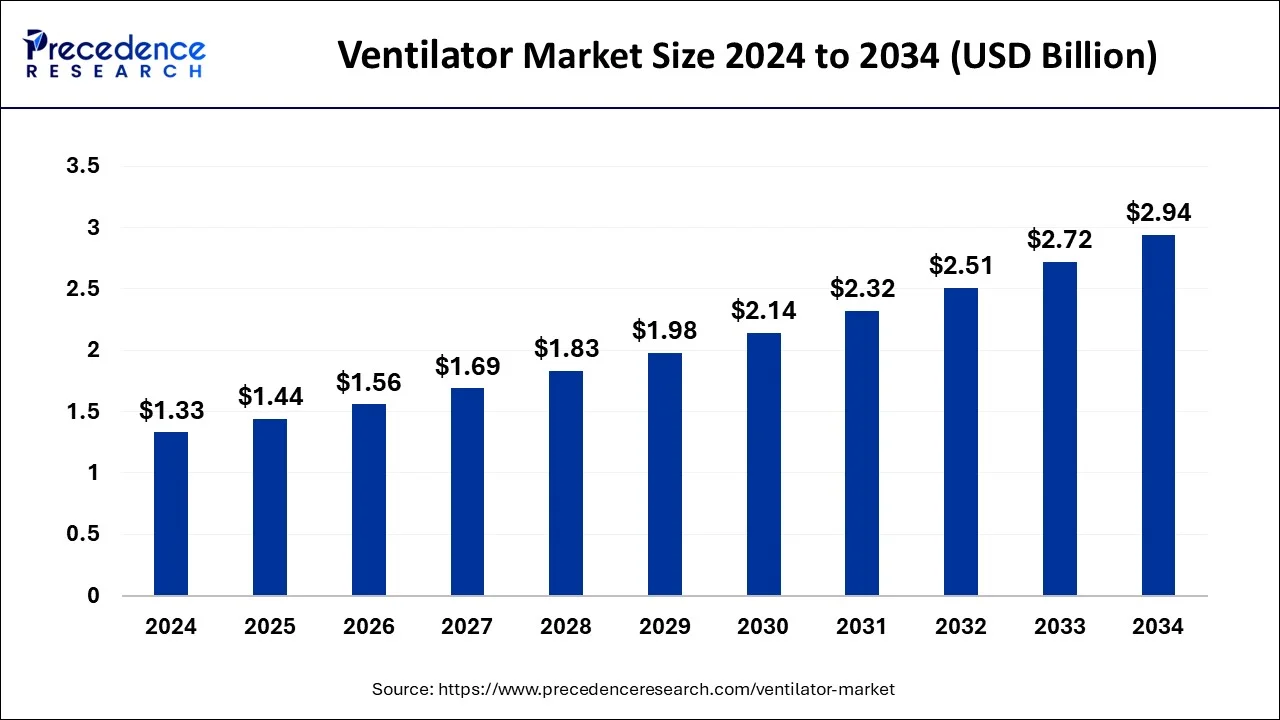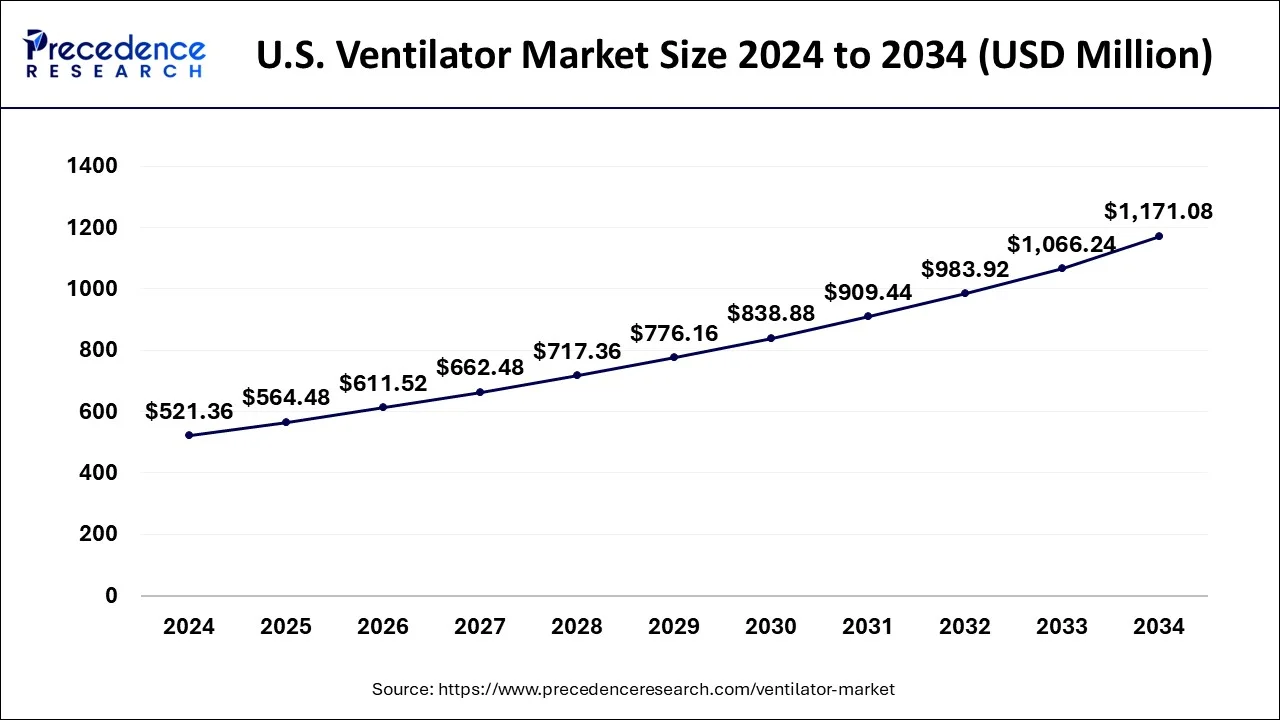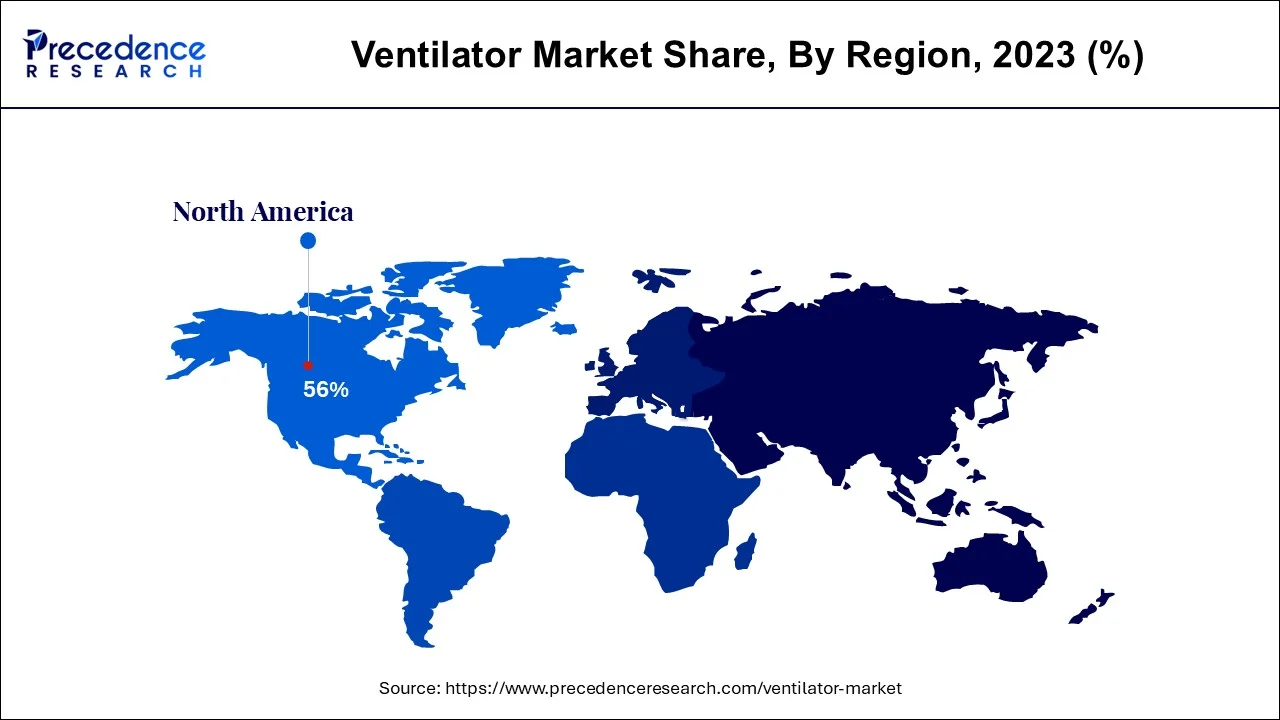The global ventilator market size was accounted for USD 1.33 billion in 2024, grew to USD 1.44 billion in 2025 and is predicted to surpass around USD 2.94 billion by 2034, representing a healthy CAGR of 8.24% between 2025 and 2034. The North America ventilator market size was calculated at USD 740 million in 2024 and is expected to grow at a fastest CAGR of 8.41% during the forecast year.
The U.S. ventilator market size was evaluated at USD 521.36 million in 2024 and is predicted to be worth around USD 1171.08 million by 2034, rising at a CAGR of 8.45% from 2025 to 2034.

The U.S. ventilator market size was evaluated at USD 521.36 million in 2024 and is predicted to be worth around USD 1171.08 million by 2034, rising at a CAGR of 8.45% from 2025 to 2034.

North America dominated the global ventilator market with revenue share of 56% in 2024, in terms of revenue and is estimated to sustain its dominance during the forecast period. North America is characterized by the rising prevalence of diseases and growing geriatric population which serves as a major factor behind the growth of the ventilator market. Moreover, the presence of developed healthcare infrastructure and presence of huge number of clinics and hospitals has fostered the growth of the market in North America. Increased disposable income, increased adoption of healthcare insurances, and increased healthcare expenditure are the few factors that drives the growth of this region. Furthermore, the increasing number of ICU admissions in the region is fueling the demand. As per the Society of Critical Care Medicine, over 5 million people gets admitted to the ICU in US per year.

On the other hand, Asia Pacific is estimated to be the most opportunistic market during the forecast period. The rapid industrialization in this region is contributing in the growth of the air pollution levels, which results in the increased number of chronic respiratory diseases. Further, rising government investments in the development of sophisticated healthcare infrastructure is further expected to increase the adoption of the ventilator across the healthcare units in the region.
The global ventilator market is primarily driven by the rising prevalence of chronic respiratory diseases among the global population owing to the rising pollution levels. According to the World Health Organization, the most common chronic respiratory diseases includes chronic obstructive pulmonary disease (COPD), asthma, occupational lung disease, and pulmonary hypertension. Around 253 million people suffer from asthma across the globe. As per the Society of Critical Care Medicine, over 5 million people gets admitted to the ICU in US per year. Around 40% to 50% of these ICU admissions requires mechanical ventilation. Therefore, the rising number of admissions to ICU is expected to boost the adoption of the ventilators in the forthcoming years.
The outbreak and rapid spread of the COVID-19 disease in 2020 resulted in the rapid growth in the demand for the ventilators across the globe. COVID-19 is a respiratory syndrome and rapid surge in the hospital admissions significantly boosted the adoption of the ventilators. The demand for the respiratory monitoring devices including the ventilators surged rapidly in 2020 owing to the rapid spread of the COVID-19 virus across the globe. According to the WHO, around 4.7 million patients were affected by the COVID-19 virus by May 2020. There is an acute shortage of ventilators across the globe. There is a huge growth potential for the ventilators manufacturers. Therefore, rising investments by the top market players to expand the production capabilities is expected to drive the growth of the global ventilator market. It is estimated that around 300% increase was registered in the demand for the ventilators during the pandemic. However, the sales level of the ventilator is expected to decline from 2021 and come back to normal levels.
| Report Highlights | Details |
| Market Size in 2024 | USD 1.33 Billion |
| Market Size in 2025 | USD 1.44 Billion |
| Market Size by 2034 | USD 2.94 Billion |
| Growth Rate From 2025 to 2034 | CAGR of 8.24% |
| Largest Market | North America |
| Base Year | 2024 |
| Forecast Period | 2025 to 2034 |
| Segments Covered | Type, Interface, End User, Region |
Environmental pollution is currently a prevalent global issue, due to which a number of stringent regulations in major developed countries in Europe and North America are being undertaken so as to develop environment-friendly policies. Sustainable energy and growth of shared mobility can largely contribute a
substantial reduction in daily fuel consumption. The mobility ecosystem has adopted electric vehicles and personal portable devices extensively in the shared mobility services. Micro mobility has seen a widespread acceptance owing to large-scale accessibility of internet, which has almost doubled globally during the past three years (2016-2019). A commuter, at present, whether partially or completely, prefers to control the service choices they are presented with. The micro mobility players in the market currently focus on reducing uncertainty in the supply chain of transportation.
The growth of the micro mobility ecosystem has been exponential due to factors such as high availability, low pricing, and ease of functioning. The growth in the adoption rate of the micro mobility services has been 10 times faster when compared with the initial growth phase of the ride sharing market. The technological revolution was largely led by China, with the growing presence of major companies such as Mobike. The strategy adopted by Mobike was mostly to increase the availability of cycles extensively at a subsidized pricing, which could restructure the buying choice toward being the renting choice in the future. The prospect of faster return on investment and lower operational cost led to many startups and mobility players to explore the business opportunity of the market. From a consumer perspective, average per mile cost by a micro mobility mode is $0.3 per mile, which is averagely $1 for a ride by a car booked via MaaS. Consumers in the developed nations have also been highly inclined toward the application of bicycles and e-bikes due to large-scale environmental and health advantage.
Most lucrative criteria for selecting a service for a consumer is cost. Micro mobility offers low cost travel option which has lured commuters to try the service for the first time. Along with cost saving, micro mobility can also save time of travel due to its compact and swift nature. The option of low-cost commute also motivates a consumer to replace their walking phase with a suitable mode for first- or last-mile connectivity. Further, national and domestic governments across the world have also identified micro mobility as a replacement to intra-city congestions during the peak traffic hours. Micro mobility services could replace cars being used for short distance travel i.e. within 5 miles (majority of trips fall under this range). Moreover, they reduce the emission caused by vehicles driven on short range trips.
“First- and last-mile” is the distance that a commuter has to cover between a transportation hub and their journey’s point of origin or destination. A transportation hub is a bus, metro, or train station, which acts as the primary mode of transportation for the passenger’s journey, covering a majority of the travel distance. A journey’s point of origin or destination is a person’s home, office, educational institution, and shopping market, among others. First-mile travel is the distance that a commuter has to cover from their origin to their destination, whereas last-mile travel is the distance that a commuter has to cover from their destination to their point of origin. As public or shared mode of transportation does not connect directly to a person’s doorsteps, these first- and last-mile distances have traditionally been covered by either people driving their cars or by walking to their destination points, which requires extensive time and efforts from the traveler and are not fuelefficient. This raises a need for a more efficient last-mile connectivity system.
In modern urban cities, the need for last-mile connectivity becomes more pertinent, as the population grows rapidly due to urbanization, traffic congestion, increase in price of vehicles, and less parking space available. This offers an ample opportunity for micro mobility service providers. The transit options for last-mile connectivity include bikes, electric scooters, cycles, skates, e-rickshaws, and shared pods, among others.
One of the most popular methods of last-mile transit mode is dockless bikes sharing systems. This mode allows the user to book a bicycle online through an app and go to any nearest parked bike by following it on their GPS. When the user reaches their destination, instead of having to park the bike in a particular kiosk, they leave the bike at any nearby parking area and pay for the service online. Several startups such as Ofo, Mobike, and Nextbike are based on this concept of operation.
The global population is expanding at an alarming rate. As per the estimates made by the UN, 55% of the global population currently resides in cities, and by 2050, this number is expected to reach 68%. With rapid urbanization, there will be more people who will require transportation for moving from one point to another, adding on to pressure on the existing transportation systems. In the absence of an efficient means of public transportation, people tend to choose personal vehicles, further complicating the situation and leading to more traffic congestion.
Micro mobility provides numerous advantages as compared with the other modes of transportation. It provides a better connectivity to the public transit, reduces the reliance of the people on their personal vehicles, and also helps in cutting down greenhouse gas emissions.
Increasing Respiratory Disease Incidences
The prevalence of lung and respiratory diseases, such as chronic obstructive pulmonary disease (COPD) and bronchial asthma that also causes post-operative complications after surgery among patients requires a consistent demand for ventilators.
According to an estimation made by the World Health Organization (WHO) in 2017, approximately 251 million individuals suffer from COPD, and three million affected individuals die each year, making it the third-leading cause of death across the globe. Similarly, approximately 334 million individuals suffer from asthma, which is one of the most common chronic diseases among children affecting nearly 14% of all children worldwide.
Air pollution also imposes high risk and severity of respiratory infections and lung diseases that can take a life-threatening form and can gradually result in death. For instance, according to the study conducted in 2017 by (IHME) in its Global Burden of Disease, air pollution attributed to five million deaths every year, accounting for 9% of total deaths caused worldwide.
respiratory infections, such as pneumonia, bronchiolitis, and influenza, are responsible for a large number of deaths annually. For instance, according to the Global Burden of Diseases, Injuries, and Risk Factors (GBD) Study conducted in 2016, lower respiratory infections led to 0.65 million deaths in children below the age of five, 1.08 million deaths in adults of age 70 years or more, and 2.37 deaths in people of all ages.
Additionally, the respective respiratory conditions are also at a higher risk of coronavirus infection as their organs are unable to offer a robust immune response. The current situation of respiratory infections has presented the worst-case scenario caused by the pandemic, and the per day count of respective disease incidence and mortality trends have been the highest caused by any infection to date.
A study by the Imperial College of London has estimated that around 30% of COVID-19 infected patients that are hospitalized may require mechanical ventilation as critically affected patients can be assisted through ventilators to offer them as the best chance of survival and thus the demand for intensive care ventilation has rocketed globally.
The life expectancy in most of the countries had surged tremendously. The improvement in life expectancy is majorly due to significant advancement in diagnostic technology and medical science and improving awareness regarding health, nutrition, and hygiene. Increasing demand for better treatment facilities with an early diagnosis of chronic diseases surges the demand for advanced treatment facilities.
The geriatric population is growing rapidly with an upsurge in demand for primary and long-term care. For instance, according to the report the World Population Ageing by United Nations in 2015, The number of people aged 65 years or older is expected to grow from an estimated 901 million in 2015 to nearly 1.4 billion in 2050, with the maximum increase in the developing countries.
Intensive care units (ICU) are a separate and self-contained hospital area with designated staff and a set of equipment that is dedicated to the management of patients with life-threatening diseases, injuries, and complications. These units have a significant role in critical care management and are categorized as an important factor to evaluate the ability to tackle an emergency. There has been a rise in the Intensive Care Unit (ICU) with an increase in healthcare funding globally.
As per the data by the National Center for Biotechnology Information (NCBI), the U.S. had a capacity of 34.2 ICU beds per 100,000 people in 2015.
An increasing number of ICU beds assure a high number of ventilator support to the patients for critical care management. However, it is estimated that there would be a shortage of ICU beds in the U.S. and several other regions post coronavirus outbreak.
Premature births are defined as the birth of the babies that are born before 37 weeks of pregnancy. According to the WHO, an estimated 15 million preterm births take place every year that is one in every ten babies is prematurely born. Preterm birth is the leading cause of death among children that are under the age of five.
Based on the type, the adult segment accounted largest revenue in 2024. This is attributed to the rising number of ICU admissions. The rising demand for the ventilators among the geriatric population who are admitted to the ICUs has boosted the growth of this segment. The growing geriatric population and rising prevalence of diseases among them is boosting the market growth. According to the United Nations, there were around 382 million old age people, aged 60 years or above, across the globe in 2017 ad this number is expected 2.1 billion by 2050.
On the other hand, the neonatal is estimated to be the fastest-growing segment during the forecast period. This is attributed to the rising incidences of preterm birth across the globe. Moreover, rising government investments in the development of sophisticated healthcare infrastructure is expected to drive the growth of this segment in the upcoming future.
Based on the interface, the invasive segment dominated the market in 2024, in terms of revenue and is estimated to sustain its dominance during the forecast period. This can be attributed to the rising number of ICU admissions across the globe. Furthermore, the rising prevalence of respiratory diseases is expected to further drive the number of the ICU admissions that is expected to boost the demand for the ventilator across the globe. Further, the demand for the invasive ventilators witness a huge surge in 2020 owing to the increased cases of the COVID-19 all over the globe.
Based on the end user, the hospitals segment dominated the global ventilator market in 2024, in terms of revenue and is estimated to sustain its dominance during the forecast period. This can be attributed to the increased penetration of hospitals across the globe. Further, the increased presence of ICUs in the hospitals have driven the adoption of the ventilators in the hospitals. The increased government and corporate expenditure in the growing the number of hospitals and ICU care in the hospitals is surging the growth of the global ventilator market.
On the other hand, specialty clinics is estimated to be the most opportunistic segment during the forecast period. This is owing to the benefits of the specialized clinics over the hospitals. The conveniences and personalized services offered by the specialized clinics is fostering the adoption of the clinical services among the population, which is expected to drive the growth of this segment in the forthcoming years.
The market is moderately fragmented with the presence of several local companies. These market players are striving to gain higher market share by adopting strategies, such as investments, partnerships, and acquisitions & mergers. Companies are also spending on the development of improved products. Moreover, they are also focusing on maintaining competitive pricing.
In April 2020, Koninklijke Philips raised its production capacity of ventilator for hospital to meet the demand-supply gap of the ventilators.
The various developmental strategies like acquisition, partnerships, mergers, and government policies fosters market growth and offers lucrative growth opportunities to the market players.
By Type
By Interface
By End User
By Mode
By Mobility
By Geography
For inquiries regarding discounts, bulk purchases, or customization requests, please contact us at sales@precedenceresearch.com
No cookie-cutter, only authentic analysis – take the 1st step to become a Precedence Research client